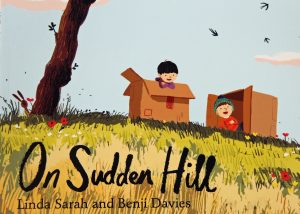 Birt and Etho are BIG friends. Playing together they let their imaginations sore and cardboard boxes become castles, yachts, rockets and space ships. Birt loves their two-by-two rhythm. Then one (cold) Monday morning a tiny boy named Shu comes along. He has been watching them play from afar and has finally plucked up the courage to ask if he can join in too – he has brought his cardboard box. Two become three, Etho welcomes Shu – but Birt feels strange …
Birt and Etho are BIG friends. Playing together they let their imaginations sore and cardboard boxes become castles, yachts, rockets and space ships. Birt loves their two-by-two rhythm. Then one (cold) Monday morning a tiny boy named Shu comes along. He has been watching them play from afar and has finally plucked up the courage to ask if he can join in too – he has brought his cardboard box. Two become three, Etho welcomes Shu – but Birt feels strange …
Two’s company, three is a crowd – a beautiful story raising philosophical questions about the nature and value of friendship.
What makes a good friend?
Is friendship a gift given freely or do we expect something in return for our friendship?
Is it possible to be lonely in a crowd?
Do we need friends to lead a good life?
Do friends shape who we are and who we will become?
What is the difference between being alone and being lonely?

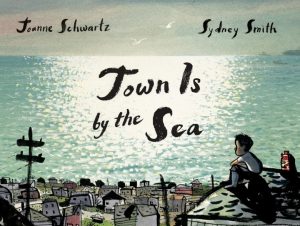 It goes like this – a boy lives with his family in a house by the sea. It’s summer and the sea is sparkling. The boy and his friend play on the only two swings that are left, there used to be four. He runs an errand for his mother. He visits his grandfather’s gravestone.
It goes like this – a boy lives with his family in a house by the sea. It’s summer and the sea is sparkling. The boy and his friend play on the only two swings that are left, there used to be four. He runs an errand for his mother. He visits his grandfather’s gravestone. 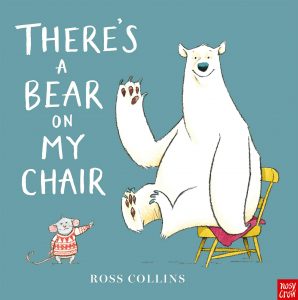 A rather large polar bear has taken up residence on a very small mouse’s chair. The mouse does everything he can think of to get the bear to move, pushing and shoving, staring him out, luring with delicious fruit… The mouse even tries frightening the bear by jumping out of a box (in his rather unsightly green underpants) to no avail. The bear won’t budge. Then the tables are turned as the bear reveals his endangered status and suddenly we become unsure of what’s right and what’s wrong.
A rather large polar bear has taken up residence on a very small mouse’s chair. The mouse does everything he can think of to get the bear to move, pushing and shoving, staring him out, luring with delicious fruit… The mouse even tries frightening the bear by jumping out of a box (in his rather unsightly green underpants) to no avail. The bear won’t budge. Then the tables are turned as the bear reveals his endangered status and suddenly we become unsure of what’s right and what’s wrong. 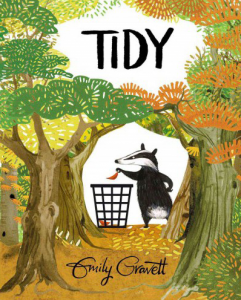 Pete the badger is obsessively tidy. It’s bad enough that his obsession encroaches on his friends personal space but then he turns his attention to cleaning up the environment… and when scrubbing and polishing rocks and picking up every single fallen autumn leaf creates a mound of plastic bags and results in the trees looking “bare and scrappy” he takes things even further. Pete’s extreme cleansing measures, as well as destroying many creatures habitat, result in him being unable to find his way home and after a hungry night spent in the bowl of a cement mixer, he finally sees his mistake. It really helps to pay close attention to the images in this story. The expression on the animals faces as Pete gives them a bath, the flower in the bin, the pile of bin bags, the hoover in the forest, the price tags on the trees…
Pete the badger is obsessively tidy. It’s bad enough that his obsession encroaches on his friends personal space but then he turns his attention to cleaning up the environment… and when scrubbing and polishing rocks and picking up every single fallen autumn leaf creates a mound of plastic bags and results in the trees looking “bare and scrappy” he takes things even further. Pete’s extreme cleansing measures, as well as destroying many creatures habitat, result in him being unable to find his way home and after a hungry night spent in the bowl of a cement mixer, he finally sees his mistake. It really helps to pay close attention to the images in this story. The expression on the animals faces as Pete gives them a bath, the flower in the bin, the pile of bin bags, the hoover in the forest, the price tags on the trees…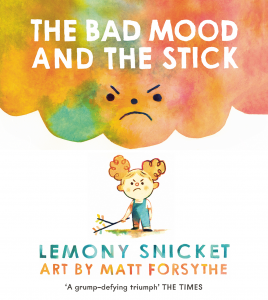 A girl named Curly is in a bad mood and happens to come across a stick which has randomly fallen to the ground. The stick comes in handy for poking her little brother and happily also relieves her of her bad mood – which has been now passed to her mum. The bad mood is passed on further and so is the stick the stick finds an unlikely home in an ice cream parlour window whose owner keeps it there because it makes him happy.
A girl named Curly is in a bad mood and happens to come across a stick which has randomly fallen to the ground. The stick comes in handy for poking her little brother and happily also relieves her of her bad mood – which has been now passed to her mum. The bad mood is passed on further and so is the stick the stick finds an unlikely home in an ice cream parlour window whose owner keeps it there because it makes him happy.